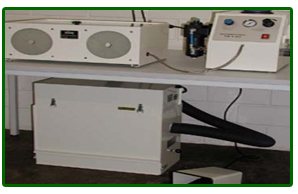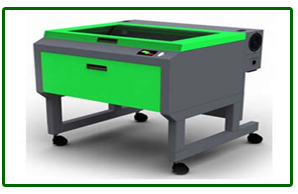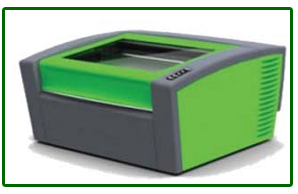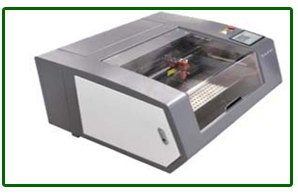Manual Hole-Drilling Machine is used in DSSC R&D to create electrolyte fill holes in glass DSC substrate.
Description:
The Manual Hole Drilling Machine uses a fast, dry process which avoids use of water and avoids constant replacement of high-cost drill-bits. Manual operation of this machine includes the holding of the work piece and the nozzle during blasting. A foot switch is used to control the length of time for blasting.
The Manual Hole Drilling Machine is used for creating electrolyte fill holes in glass substrates during the initial stage of glass electrode preparation. Accurate holes are produced by application of fine, high-pressure blasting media onto the substrate.
The system includes a double filtration system for capturing dust that is formed during the blasting process. A clear safety window allows for viewing inside the blasting chamber during the blasting process.
Manual Hole Blasting machine requires that the user manually holds the blasting nozzle in place to drill the holes. Blasting media application time is manually controlled by the use of the supplied foot pedal control.
Specifications:
| Features | Description | Benefit | |
| Grit Media | Grit sizes from 10 µm to 300 µm | Can accommodate most common grades of grit media | |
| Control Grit Dosage | Manual control of grit dosage | Allows user to control speed and pressure delivery of grit media to substrate | |
| Machine Requirement | -Electricity: 230V AC, 50Hz- Air Supply: 8 bar maximum Clean, Dry, Air Compressor | ||
| Substrate Sizes | 430 mm (L) x 270 mm (W) | Accommodates a range of DSC substrates | |
Use:
Laser Scribing Machine is used in DSSC R&D to remove the conductive oxide layer from glass substrates to produce a series connect cell.
Description:
The Laser Scribing Machine uses a carbon dioxide laser, producing a continuous cut, which is used to remove the conductive oxide layer from glass substrates to produce a series connect cells. The software allows the machine to be programmed for specific cells and designs.
The system provides the wavelength, suitable for plastics and glass. There is a slight etching of the substrate where the TCO is removed.
Advantages:
- Precision scribing
- Use of your own CAD files
- High speed operation.
Specifications:
| Features | Description | Benefits | |
| Control Features | Computer control system allows user to define scribing design | High precision control system puts you in charge | |
| CO2 Laser | Wavelength 10.6 microns, Class 3a.Available in; 10, 25 and 30Watts | Carbon dioxide lasers provide the highest power, continuous wave laser with high efficiency and is suitable for scribing glass and plastic | |
| Repetition Rate | Depend on the printed pattern and the speed of the laserUp to 75cm/sec | High speed operation for quick production times | |
| Machine Requirements | -Electricity: 220V AC, 50Hz, 10/5Amps, -Exhaust system and ducting supplying 7 cubic meters per minute of air at 15cm of static pressure (water), -Air-conditioning |
||
| Substrate Size(L x W x H) | 737 mm x 584 mm x 229 mm | Accommodates a range of DSC substrates | |
| Lens Options | Spot size is dependent on the lenses that are chosen when the laser is purchased. 4 Options available, the standard option is in bold: Focal length Spot Size Resolution 38.1mm 0.08mm 1000 x 1000 DPI 50.8mm 0.13mm 500 x 500 DPI 63.5mm 0.18mm 333 x 333 DPI 101.6mm 0.33mm 250 x 250 DPI |
Changeable lenses enable you to specify the spot size as per your requirements. The smaller the beam size the faster the cutting | |
Use:
Laser Scribing Machine is used in DSSC R&D to remove the conductive oxide layer from glass substrates to produce a series connect cell.
Description:
The Laser Scribing Machine uses a carbon dioxide laser, producing a continuous cut, which is used to remove the conductive oxide layer from glass substrates to produce a series connect cell. The software allows the machine to be programmed for specific cells and designs.
The system provides the wavelength, suitable for plastics and glass. There is a slight etching of the substrate where the TCO is removed.
Advantages:
- Precision scribing
- Use of your own CAD files
- High speed operation.
Specifications:
| Features | Description | Benefits | |
| Control Features | Computer control system allows user to define scribing design | High precision control system puts you in charge | |
| CO2 Laser | Wavelength 10.6 microns, Class 3a.Available in; 10, 25 and 30Watts | Carbon dioxide lasers provide the highest power, continuous wave laser with high efficiency and is suitable for scribing glass and plastic | |
| Repetition Rate | Repetition rate is dependent on printed pattern and speed of the laserUp to 75cm/sec | High speed operation for quick production times | |
| Machine Requirements | -Electricity: 220V AC, 50Hz, 10/5Amps, -Exhaust system and ducting supplying 7 cubic meters per minute of air at 15cm of static pressure (water), -Air-conditioning |
||
| Substrate Size(L x W x H) | 476mm x 370mm x 102mm | Accommodates a range of DSC substrates | |
| Lens Options | Spot size is dependent on the lenses that are chosen when the laser is purchased. 4 Options available, the standard option is in bold: Focal length Spot Size Resolution 38.1mm 0.08mm 1000 x 1000 DPI 50.8mm 0.13mm 500 x 500 DPI 63.5mm 0.18mm 333 x 333 DPI 101.6mm 0.33mm 250 x 250 DPI |
Changeable lenses enable you to specify the spot size as per your requirements. The smaller the beam size the faster the cutting | |
Use:
Laser Scribing Machine is used in DSSC R&D to remove the conductive oxide layer from glass substrates to produce a series connect cell.
Description:
The Laser Scribing Machine uses a carbon dioxide laser, producing a continuous cut, which is used to remove the conductive oxide layer from glass substrates to produce a series connect cell. The software allows the machine to be programmed for specific cells and designs.
The system provides the wavelength, suitable for plastics and glass. There is a slight etching of the substrate where the TCO is removed.
Advantages:
- Precision scribing
- Use of your own CAD files
- High speed operation.
Specifications:
| Features | Description | Benefits | |
| Control Features | Computer control system allows user to define scribing design | High precision control system puts you in charge | |
| CO2 Laser | Wavelength 10.6 microns,Available in; 40Watts | Carbon dioxide lasers provide the highest power, continuous wave laser with high efficiency and is suitable for scribing glass and plastic | |
| Repetition Rate | Repetition rate is dependent on printed pattern and speed of the laserUp to 100cm/sec | High speed operation for quick production times | |
| Machine Requirements | -Electricity: 220V AC ±10%, 50Hz, -Exhaust system and ducting supplying 7 cubic meters per minute of air at 15cm of static pressure (water), -Air-conditioning |
||
| Substrate Size(L x W x H) | 620mm x 300mm x 100mm | Accommodates a range of DSC substrates | |
| Lens Options | Spot size is dependent on the lenses that are chosen when the laser is purchased. 4 Options available, the standard option is in bold: Focal length Spot Size Resolution 38.1mm 0.08mm 1000 x 1000 DPI 50.8mm 0.13mm 500 x 500 DPI 63.5mm 0.18mm 333 x 333 DPI 101.6mm 0.33mm 250 x 250 DPI |
Changeable lenses enable you to specify the spot size as per your requirements. The smaller the beam size the faster the cutting | |




